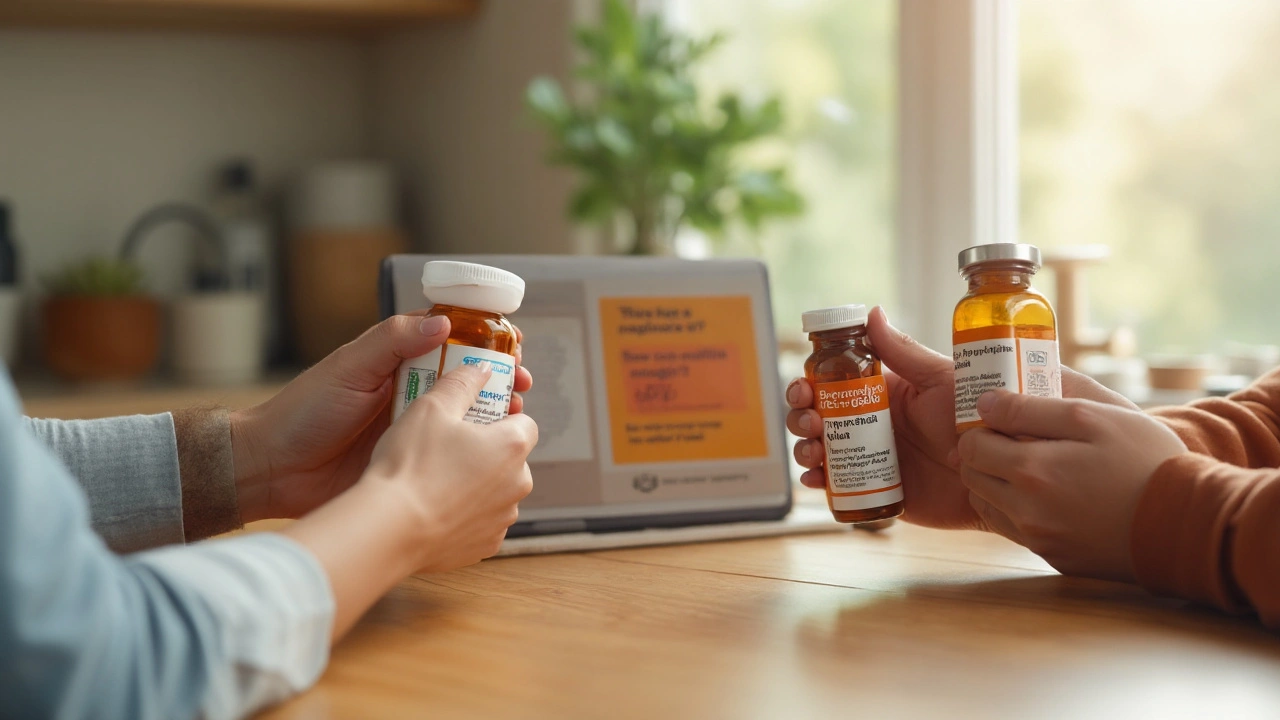If you or your kids keep waking up with that nagging chesty cough or persistent congestion, you know how quickly it gets in the way of school, work, and sleep. Bromhexine, a popular active ingredient in many cough and cold medicines, shows up in pharmacy aisles for good reason: it helps thin out thick mucus, making it easier to breathe and recover. But with so many new brands and combos on the shelf this year, picking the right one can feel overwhelming—especially with kids (and stubborn grownups!) in the house. Here’s what works, what doesn’t, and how to make the smartest choice for your family’s lungs in 2025.
- Some bromhexine combos are better for dry cough, others target stubborn mucus.
- The best bromhexine medicine depends on age, health, and allergies—don’t just grab what’s cheapest.
- Always check updated dosing and avoid mixing with certain other cold drugs.
- Pediatric use: Check age limits and flavors to dodge home battles over "yucky medicine."
What to Know Before Choosing a Bromhexine Medicine
The first thing to figure out is whether you need a medicine with just bromhexine or an added mix. Plain bromhexine is mostly for those stubborn, chesty coughs where thick phlegm won’t come up. But in 2025, many brands add other stuff—like guaifenesin (for even more mucus-busting), paracetamol (for fever), or antihistamines (for allergy symptoms).
When shopping, ask yourself these questions:
- What’s the main symptom—just mucus, or cough plus fever/body aches?
- Is the patient a child or adult? Age matters for strength and safety.
- Any pre-existing conditions (like asthma, diabetes) that rule out certain ingredients?
- Any allergies to dyes, flavorings, or inactive ingredients?
In South Africa, you can buy most bromhexine meds over the counter, but there are new combo products and imports as well, so always check the box for registration by the South African Health Products Regulatory Authority (SAHPRA).
Top 10 Bromhexine-Containing Medicines for Respiratory Relief in 2025
Here’s the run-down on the most trusted and widely stocked bromhexine medicines in 2025, based on what local pharmacists recommend and my own family’s experience (especially with Briony’s epic winter colds!).
| Brand Name | Best For | Key Ingredients | Age Range | Notable Comments |
|---|---|---|---|---|
| Bisolvon | Thick, stubborn mucus | Bromhexine 8mg/tab, 4mg/5ml syrup | 6+ years | Classic, works fast, no sugar version |
| Mucosolvan | Mild to moderate congestion | Ambroxol (a bromhexine derivative) | 12+ years (6+ with pediatric syrup) | Gentler on sensitive stomachs |
| Broncleer | Chesty cough with phlegm | Bromhexine, guaifenesin | 18+ years | Strong, not for kids |
| Linctagon-C | Colds with cough, sore throat | Bromhexine, vitamin C, pelargonium | 6+ years | Herbal boost, less chance of drowsiness |
| Bronchicum Elixir S | Wet cough, sensitive users | Bromhexine, thyme extract | 2+ years | No artificial color/flavor; popular for kids |
| Coryx Throat & Chest Syrup | Cough with allergies | Bromhexine, chlorphenamine | 12+ years | Tackles runny nose too |
| Phlemex | Mucus and fever | Bromhexine, paracetamol | 6+ years | Combination for bad colds |
| Mucusol | Stubborn phlegm, bronchitis | Bromhexine 8mg | 6+ years | No dye or alcohol |
| Solvin | Fast, daytime relief | Bromhexine, menthol | 12+ years | Cools the throat, for adults/teens |
| Bounce Junior Cough | Mucus in toddlers | Bromhexine, honey, herbal extracts | 2–6 years | Sugar-free, easier on fussy kids |
For most adults dealing with seasonal colds or thick chest congestion, the classic bromhexine medicines like Bisolvon hit the sweet spot for fast relief. If there’s fever, combo products with paracetamol like Phlemex can simplify your medicine cabinet. But when shopping for kids, always check the dosing charts—some products are strictly adult-strength, and a syrup that works for teens can be a bad fit for a toddler.
Bromhexine Medicine Comparison: Which Should You Choose?
Bromhexine is well-tolerated, but it’s not one-size-fits-all. Here’s what stands out between the options above and which product suits which situation best:
- Fast daytime relief: Solvin (adults/teens), Mucusol (general use); both avoid drowsy add-ons.
- For children: Bounce Junior Cough and Bronchicum Elixir S skip harsh flavors and excess sugar, making medicine time less of a battle.
- Allergic symptoms and runny nose: Coryx Throat & Chest adds an antihistamine, so it won’t suit those needing non-drowsy options.
- Plant-based or natural: Linctagon-C and Bronchicum have herbal supports if you prefer fewer straight chemicals.
- Combination for multiple symptoms: Phlemex covers cough, mucus, and pain—but don’t double up on paracetamol elsewhere.
The big pitfall: doubling up on the same ingredient across cough, flu, and cold meds. My own GP once pointed out that layering paracetamol-based combos can push you over safe daily limits. So always keep tabs on what’s in each bottle before stacking.

Bromhexine Use: Pro Tips, Pitfalls, and Practical Rules
For everyday cough and congestion, bromhexine has a decades-long record. Still, new brands streamline dosing, drop sugar, and add flavors, which makes a difference for picky kids or those on sugar-restricted diets. Here’s what I’ve learned as a Durban dad (and reluctant family medicine guinea pig):
- Start with the lowest effective dose and increase if there’s no change in 24–48 hours.
- Don’t use bromhexine for dry, tickly coughs—it’s best for thick, productive phlegm.
- If using for kids under 6, double-check the label and use a dosing syringe, not a kitchen spoon.
- Avoid using combo products with sedating antihistamines on school days—they can make kids groggy.
- Watch out for skin rashes or stomach upsets—these are rare but possible side effects.
The World Health Organization notes:
"Bromhexine has demonstrated strong safety and modest efficacy when used according to recommended guidelines, but its use should be individually tailored to symptom profile and patient age."
If your cough lasts more than seven days, or if it comes with shortness of breath, fever that won’t break, or chest pain, seek advice—don’t keep self-medicating. Chronic lung conditions like asthma, or any persistent or unexplained cough, should always go through your doctor.
Quick Reference Table: Side Effects, Age Limits, Combo Dangers
| Product | Main Side Effects | Contains Paracetamol? | Contains Antihistamines? | Kid-Friendly |
|---|---|---|---|---|
| Bisolvon | Rare rash, mild stomach upset | No | No | Yes (6+ with syrup) |
| Linctagon-C | Mild digestive | No | No | Yes |
| Phlemex | Liver risk if overdosed | Yes | No | Older kids only |
| Coryx Throat & Chest | Drowsiness | No | Yes | No |
| Broncleer | Drowsiness, may cause habit | No | Yes | No (adults only) |
| Bounce Junior Cough | Rare allergic reactions | No | No | Yes (2–6) |
Mini-FAQ: Bromhexine Questions You Might Still Have
- Is bromhexine safe during pregnancy? Most resources say avoid if possible, especially in the first trimester. Always ask a healthcare provider first.
- How long does it take to work? Most people notice thinner mucus and easier breathing within 12–24 hours.
- Can I mix bromhexine with asthma medicines? Usually yes, but asthma and chronic lung sufferers should check with their doctor first.
- Does it treat infections? No. Bromhexine only helps with symptoms, not bugs. If there is persistent fever or green/bloody mucus, see a doctor for antibiotics if needed.
- Liquid or tablet—which is better? For kids or anyone with swallowing trouble, syrups are smoother. Tablets and capsules work as well but are more convenient for adults.

Where to Go From Here? Next Steps for South African Shoppers
- Parents: Check kid-specific dosing and flavors. Try Bronchicum or Bounce Junior to avoid fights over taste.
- Asthmatics or chronic lung: Check with your specialist before adding a new over-the-counter medicine to your mix.
- Bargain hunters: Pharmacy generics with bromhexine may save you money and work just as well as name brands—just be sure they’re SAHPRA licensed.
- Anyone with ongoing cough: Don’t mask something serious—seven-day rule, and check for red-flag symptoms like blood in mucus or fever that won’t budge.
Bromhexine medicines can’t solve every cough, but they’re a great tool when thick, lingering mucus is the real enemy. Know what you’re buying, read every label (yes, every label), and ask your pharmacist if you’re stuck—no shame in getting backup. The right choice means less time coughing and more time enjoying Durban’s beaches, school runs, or, if you’re me, sleep without hacking half the night.





tony ferreres
August 22, 2025 AT 11:47Bromhexine is a go-to when the chest is full of gluey mucus and sleep is getting wrecked.
Start with the smallest effective dose and keep an eye on combo ingredients right from the first read of the box, especially paracetamol overlaps and antihistamines that can sop energy during the day.
For parents, the syrup options that skip artificial color and sugar are worth the premium because medicine time becomes less of a battlefield and dosing is more accurate with a syringe.
SAHPRA registration matters for imports, and generics are fine if they display proper registration and dosing info.
Lastly, track how someone responds for 24 to 48 hours and stop if new rashes or belly issues pop up.
Emoji note: a thumbs up for responsibly using pharma, and a coffee emoji for surviving the night shift with a sick kiddo. 👍☕
Kaustubh Panat
August 24, 2025 AT 03:46Plain bromhexine has been underappreciated because marketing now insists every cough needs a dozen extras, none of which are always helpful.
Pharmacologically speaking, bromhexine accelerates mucus clearance by enhancing mucociliary transport and thinning secretions, and that alone fixes a surprising number of productive cough presentations without sedatives or analgesics interfering with daily function.
When combinations are sold as convenience, the buyer bears hidden risks, most notably duplicated paracetamol exposure and sedating antihistamines that transform daytime functioning into a soporific experiment.
Quality control across markets varies, and the regulatory stamp should be nonnegotiable for anyone purchasing imports or private-label generics.
Pediatric formulations deserve exacting attention because concentration, excipients, and palatability shift the risk–benefit calculus in tiny bodies, and dosing errors are a common avoidable harm.
Herbal adjuncts like pelargonium or thyme are often framed as benign, but they add pharmacodynamic complexity and sporadic allergic potential that clinicians see more than marketing admits.
Ambroxol derivatives do similar jobs to bromhexine in many respects, but they are pharmacologically distinct enough to matter for side effect profiles in sensitive users.
For patients with chronic lung disease, even a brief course of an OTC mucolytic should be reported to the treating specialist to avoid untracked symptom masking or interactions with inhaled regimens.
Liver safety is not a bromhexine issue per se, but it becomes relevant the moment paracetamol is present in a combo product, and that multiplies risk if people are unaware they are doubling up with other analgesic-containing drugs.
From a prescriber’s vantage, the ideal patient for bromhexine is one with clear productive cough and no contraindicative comorbidity, using the lowest effective dose for the shortest reasonable period.
Practical dispensing advice is simple: pharmacists should flag duplicate actives at the point of sale and caregivers should always be advised on what to watch for in the first 48 hours.
Consumer education campaigns would reduce harms far faster than another branded syrup launch, because people routinely ignore fine print when bedtime coughs drive desperation purchases.
For the empiric consumer, shelf selection should privilege single-active formulations for short-term use and reserve combos for clearly symptomatic multisystem disease when under direct guidance.
In short, bromhexine works best when it is used modestly, transparently, and with an eye to overlapping ingredients that too often turn helpful remedies into problematic stacks.
There is merit in having a couple of trusted brands at home, but rotating products or buying on price alone increases the odds of confusing ingredients during an illness.
Keep a simple log of what you gave and when, especially for kids, because clarity beats guesswork every time.
Johnny X-Ray
August 26, 2025 AT 11:20Used Bisolvon for years, no fluff, clears the chest fast.
tabatha rohn
September 4, 2025 AT 17:33Avoid sedating antihistamine combos on school days and workdays because the grogginess is real and people write it off as tiredness when it is drug effect.
Also, paracetamol in combination syrups is a liver hazard when parents give separate fever meds at night without checking labels, and that simple oversight is one of the nastiest pitfalls.
Label reading is not optional, and anyone who skips it is taking a gamble with their kid or themselves.
Gaurav Joshi
September 4, 2025 AT 18:33That grogginess warning is overstated for most kids and turns cautiousness into needless fear.
Most parents can manage timing and still get effective symptom relief without making everything a crisis.
Annie Eun
September 7, 2025 AT 01:06Practical tip for caregivers: always use a dosing syringe and mark the child dosing schedule on the box so no one doubles doses after a midnight wake.
Store syrups away from direct heat and check expiry dates even on unopened packs because cold chain issues can degrade active ingredients in some regions.
For toddlers, honey blends might seem soothing but they are only appropriate above a certain age, and cough soothing is best paired with humidified air and fluids.
If pregnancy is a factor, seek a professional recommendation rather than relying on lists, and avoid making medication choices based on taste or adverts alone.
Jay Kay
September 8, 2025 AT 04:53Always check the active ingredient lines and not just the brand, then keep it simple and consistent.
Franco WR
September 16, 2025 AT 07:20When my partner and our kid both caught a nasty winter chest bug, we learned that bromhexine plus steam and fluids made the nights survivable.
We alternated doses strictly and kept a kitchen timer on for meds, and the clear benefit surfaced within a day for productive coughs while dry coughs barely budged.
Hydration helped mucus thin naturally and steam from the shower gave immediate short-term relief before the meds showed effect.
We avoided any paracetamol combos unless the fever was high because the priority was mucus clearance and not masking the clinical picture.
For long-term sufferers, mucolytics are best used as part of a plan with the specialist, because chronic coughs often hide underlying issues that simple OTCs will only temporarily soothe.
Empathy matters during sleepless nights and clear communication with whoever is caring for the child or partner prevents accidental overdosing or missed doses.
Finally, confidence in a chosen product comes from consistent, safe use and keeping a very small home med record so the next caretaker knows what was given and when.
Rachelle Dodge
September 21, 2025 AT 09:33Sensible, tidy advice that treats medicine like a tool and not a talisman.
Keep it simple, keep records, and treat the body with basic kindness while the drugs do their job.